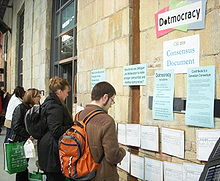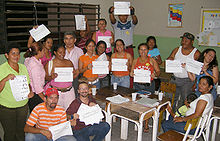- Dotmocracy
-
Dotmocracy is an established facilitation method[1] for collecting and recognizing levels of agreement on written statements among a large number of people. Participants write down ideas on paper forms called Dotmocracy sheets and fill-in one dot per a sheet to record their opinion of each idea on a scale of “strong agreement”, “agreement”, “neutral”, “disagreement”, “strong disagreement” or “confusion”. Participants sign each sheet they dot and may add brief comments. The result is a graph-like visual representation of the group's collective opinion on each posted statement.
The term "dot-mocracy" is sometimes used to describe voting with dot stickers [2], also known as “multi-voting”, “dot-voting”[3][4] or “voting with dots”[5]. In multi-voting participants vote on their favorite options using a limited number of stickers or marks with pens - dot stickers being the most common. This sticker voting approach is more accurately described as cumulative voting.
Dotmocracy could be considered an application of range voting which has been shown to produce the lowest Bayesian regret among common voting methods, even when voters are strategic.
Contents
History
In 2004, as part of an initiative to introduce more participatory democracy at Karma Food Co-op in Toronto, Canada, then president, Jason Diceman, introduced the use of Dotmocracy sheets[6] where participants were invited to write ideas and apply dot stickers on a grading scale of "A - Strong Approval," "B - Approval," "C - Acceptance," "D - Concern," "F- Objection," or "? - Unclear” for each idea.
Diceman published a revised version of the Dotmocracy sheet, along with defined steps and rules as part of his first Dotmocracy Handbook that was distributed at the 2006 National Conference on Dialogue & Deliberation in San Francisco, California. Diceman continues to release new versions of the Dotmocracy Handbook and Dotmocracy Sheets for free on the Dotmocracy Website.
The use of Dotmocracy sheets continues to be adopted by facilitators and organizations in Canada and internationally[7][8][9][10]
Process specifics
The Dotmocracy process prescribes the following essential steps for large group decision-making:
- Participants learn about the issue.
- A hosting organization presents the issue and asks specific questions.
- Participants discuss potential answers in small groups.
- Participants write ideas on Dotmocracy sheets.
- Participants fill dots on Dotmocracy sheets to record their opinions and optionally write comments. Repeat steps 3 through 5.
- The facilitator reports on the results of the process.
- The hosting organization formulates and announces a decision based on the Dotmocracy results.
The basic rules for Dotmocracy are as follows:
- Recognized Dotmocracy facilitators are authoritative and responsible for the Dotmocracy process but neutral on the content.
- Each participant may only fill one dot per a Dotmocracy sheet.
- Participants must sign each sheet that they dot.
- Participants may dot as many or as few sheets as they please.
- There are no changes to an idea's text inside the idea box once dotting has started.
- Participants are always invited to post new ideas.
- Participants have the right to contribute anonymously.
- A Dotmocracy sheet should only be removed from the dotting process according to the recognized facilitators' judgment.
Dotmocracy is generally facilitated within a large meeting, but can also be conducted outside of meetings using a Dotmocracy wall where Dotmocracy sheets are posted on a wall with an open invitation for participation.
Relation to consensus decisions-making
Dotmocracy sheets complement a consensus decision-making process by providing a simple way to visibly document levels of agreement among participants on a large variety of ideas. The Step-by-Step Process and Rules defined in the Dotmocracy Handbook[11] reinforce consensus decision-making by promoting equal opportunity, open discussion, the drafting of proposals, the identification of concerns and the encouragement of idea modification.
Comparison to voting
Although Dotmocracy could be considered an application of range voting, it is quite different than most common voting systems since it does not necessitate a choice between options. No participant is required or expected to consider every option. Each option is judged for its own merit. Those who record their opinion on each Dotmcoracy sheet are assumed to be a representative sample of the full group. Dotmocracy sheets are intended to help decision-makers recognize group preferences.
References
- ^ http://www.iaf-world.org/i4a/pages/index.cfm?pageid=3280 International Association of Facilitators Resource Center lists the Dotmocracy Handbook under a short list of Methods & Techniques.
- ^ http://www.torontohousing.ca/participatory_budgeting Explanation of the Toronto Community Housing participatory budgeting process.
- ^ http://my.safaribooksonline.com/0321268776/ch15lev1sec10 Book “Collaboration Explained: Facilitation Skills for Software Project Leaders” page 129.
- ^ http://www.innovationtools.com/Articles/ArticleDetails.asp?a=141 “Group Brainstorming: Dot Voting with a Difference” article.
- ^ http://www.albany.edu/cpr/gf/resources/Voting_with_dots.html A compiled thread from a discussion on the Electronic Discussion on Group Facilitation, 20 December 2000.
- ^ http://www.karmacoop.org/committees/chronicle/archives/dec-jan_2005.pdf Karma Food Co-op Newsletter, December 2004.
- ^ http://www.anecdote.com.au/archives/2008/07/trust_creating.html Blog posting about Dotmocracy used at Knowledge Management Conference in Australia, by founder of Anecdote Consulting, Shawn Callahan.
- ^ http://www.med.ubc.ca/__shared/assets/Physician_Health_Program_of_BC_Annual_Education_Conference4998.pdf 2008 Physician Health Program of BC Annual Education Conference agenda lists a 45 minute Dotmocracy plenary session.
- ^ http://www.flickr.com/photos/jonstahl/tags/dotmocracy/ Photos by Jon Stahl of Dotmocracy sheets in use at the Plone Strategic Planning Summit 2008 in California, USA.
- ^ http://dotmocracy.org/who_uses “Who Uses Dotmocracy?” section of Dotmocracy.org
- ^ http://dotmocracy.org/handbook Dotmocracy Handbook
Categories:- Group processes
- Collaboration
- Collective intelligence
- Deliberative methods
- Unconferences
Wikimedia Foundation. 2010.




